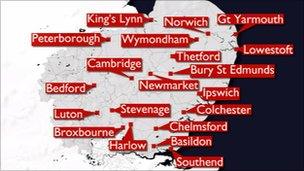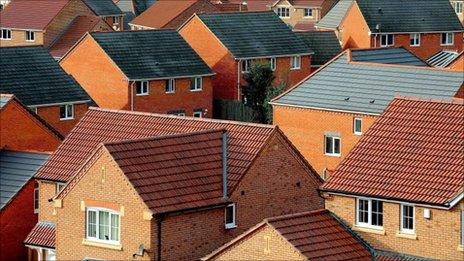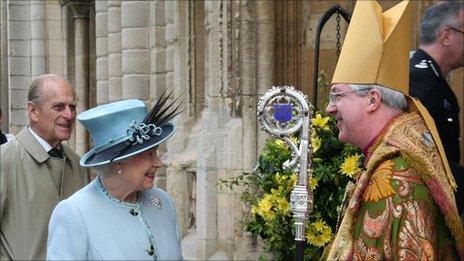Fears for green field sites with latest planning advice
- Published
- comments

The Campaign to Protect Rural England (CPRE) says all these towns could see development
When the new government came in, one of the first things it did was abolish regional planning strategies and controversial proposals for eco-towns.
It talked a lot about 'localism' - letting communities rather than distant politicians decide where developments should go.
It left some people with the impression that local opinion would rule; that if there was an unpopular housing scheme, it wouldn't go ahead.
But it's not going to be as easy as that.
The government has published new planning advice to councils, the National Planning Policy Framework, external, telling them to make provision for more development and give more permission for new developments.
And they've also been told that in the event of disputes the default answer to new development will be 'yes'.
Campaign groups say that will mean thousands of new homes will now be built in the East - many on green field sites.
"Every developer is dusting off his old plans and getting ready to put them back into the planning system again," says Sean Traverse-Healy, the vice-chairman of the eastern branch of the Campaign to Protect Rural England, external (CPRE).
"And with a weakened planning system some of them will succeed where they might have otherwise failed."
The National Trust, external has taken the unusual step of launching a petition against the plans. Over the weekend more than 2,000 visitors to its properties signed it.
"The National Trust exists to protect special places for everyone for ever," says its spokesman Claire Graves.
"It's not just places we own. It's whatever is your special place, where you walk your dog, where you spend some time with your family. Those places could be at risk if they're not protected by local authorities."
The government insists that it values the countryside and it says green spaces which are valuable to local communities will still be protected.
But a spokesman for the Department for Communities and Local Government , externaltold the BBC: "House-building fell to record levels under the last government and that needs to be addressed.
"We will allow local communities to make decisions for themselves, they can decide what's suitable and where it goes but they can't block development."
In other words there is an expectation that new homes will be built. Just saying 'no' to development applications will not be acceptable.
Worried communities
A couple of years ago the old East of England Regional Assembly estimated that our region will need an extra 728,000 new homes by 2031. Just about every town in the region along with many villages would be affected.
"We need houses in the right place but the right place is not in the middle of the countryside," says Mr Traverse-Healy of the CPRE.
"It (should be) brown field land and within urban areas first and only then and when it's absolutely necessary should we think about putting housing into the countryside."
Mr Traverse-Healy worries there are not many brown field sites in many parts of the region. If councils are made to allow more housing it's inevitable, he argues, that a lot of it will go in the countryside.
Across the East there are dozens of communities worried about speculative housing developments.
As the proposals make their way through the planning system, we will start to get some idea of the impact this new planning guidance could have on our region.
- Published4 August 2011

- Published7 July 2011

- Published14 March 2011